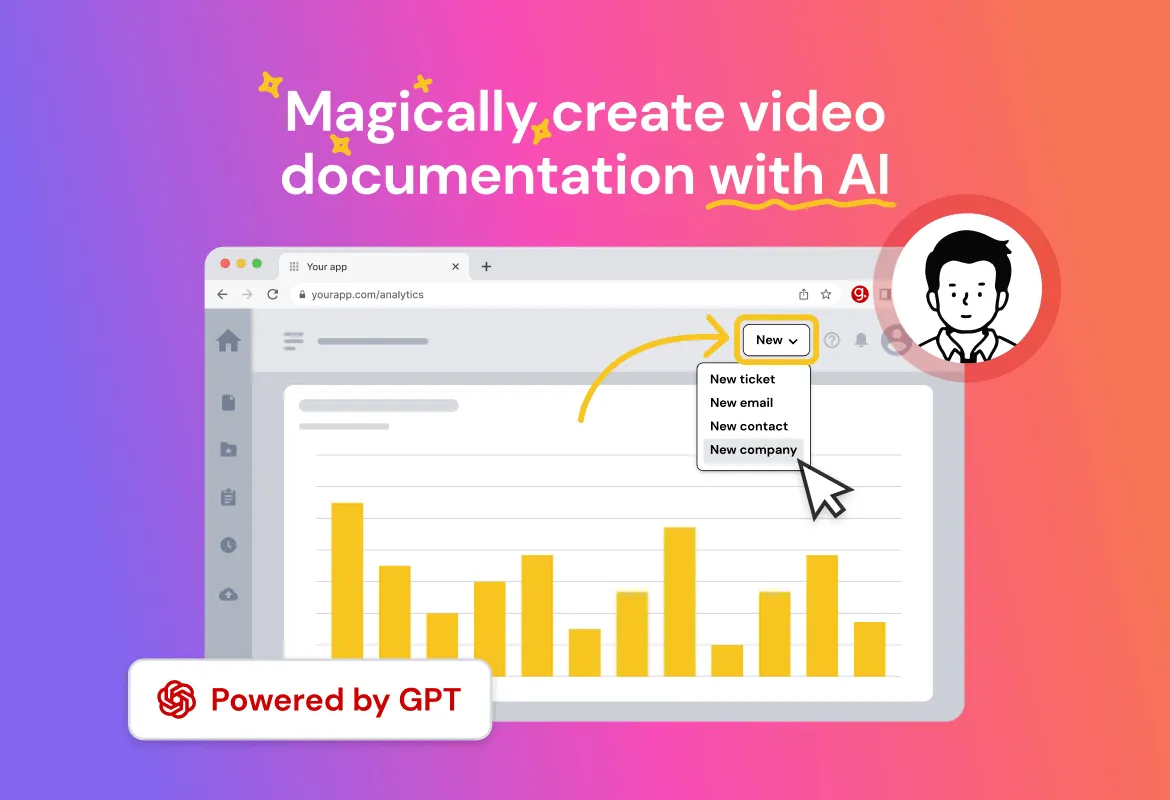5 Innovative Ways to Increase Customer Satisfaction with Technology
Explore innovative technology solutions to improve customer satisfaction scores. Drive loyalty and engagement with AI, chatbots, gamification, and more.
Published April 17, 2024.

Traditional customer service methods can feel clunky and impersonal. Customers get stuck on hold, wait for responses to emails, and sometimes interact with representatives who need more complete knowledge.
This frustration leads to customer churn, negative reviews, and lost business. In today's competitive landscape, a bad user experience can travel fast and do serious damage to your brand reputation.
But there's hope. Innovative technologies, such as automation, are changing how companies focus on customer service. By implementing these solutions, you can create a more engaging and efficient experience, improving satisfaction.
What Is Customer Satisfaction?
Customer satisfaction (CSAT) is a metric that reflects how well a company meets expectations. Working on improving it leads to loyalty, repeat business, and positive word-of-mouth marketing for your brand.
In today's competitive market, customer satisfaction is a critical advantage. Businesses can significantly reduce wait times by implementing streamlined processes using technology, directly improving their CSAT.
Note: Many companies effectively leverage technology to improve CSAT. Hilton uses AI-powered chatbots to assist guests with booking, while Adidas has a community space offering free fitness sessions.
» Looking for happy customers? Explore ways to increase your CSAT score
5 Technology Solutions That Improve CSAT
1. Self-Service Portals
User-friendly digital platforms empower customers to take control of their experience. These self-service portals provide convenient and efficient ways to improve satisfaction by enabling users to do the following:
- Find answers: Extensive knowledge bases, searchable FAQs, and interactive tutorials equip customers with the information they need to troubleshoot issues or answer basic questions themselves.
- Manage accounts: Secure online portals enable users to view account information, update details, make payments, and manage subscriptions independently.
- Resolve issues: Online forms, chatbots, and troubleshooting guides empower customers to diagnose problems. They can use the knowledge to potentially resolve common issues without needing to contact customer service representatives directly.
This shift towards self-service benefits both parties. Customers appreciate the convenience, flexibility, and 24/7 accessibility of these digital tools. On the other hand, businesses can handle a larger volume of interactions with increased efficiency to reduce labor costs.
» Explore metrics that measure customer satisfaction and boost sales
2. Customer Service Gamification
Companies can transform customer service by incorporating game-like elements. It'll foster a more engaging and rewarding experience for customers and service representatives.
Imagine that completing a customer satisfaction survey is no longer a chore. It can be an opportunity to earn points towards a virtual badge or unlock exclusive discounts.
You could also gamify paying bills by introducing progress bars that fill with each on-time payment, ultimately leading to a reward like a free service upgrade. By turning mundane tasks into interactive experiences, gamification keeps customers engaged and motivated.
3. AI-Powered Customer Service
AI can anticipate needs and proactively offer solutions to customers. For example, an AI-powered chat window can pop up to provide personalized recommendations based on the customer's browsing history. You could even use it to suggest laptops with features similar to those in previous searches.
This proactive approach improves customer satisfaction by saving them time and effort when looking for a laptop by themselves. It also creates opportunities for relevant upselling and cross-selling, increasing sales without feeling pushy.
By addressing these concerns before they turn into problems, AI can also significantly reduce the need for reactive customer service interventions, leading to cost savings for the business.
Note: guidde is one of the companies at the forefront of AI innovation, offering tools to create personalized video documentation and training materials. This approach reduces reliance on manual knowledge base building and creates a satisfying customer journey.
4. AI-Driven Data Analytics
The powerful combination of AI and data analytics is transforming how businesses understand their customers. Companies can use it to get insights from a variety of sources, such as transactional histories, website behavior, and social media interactions.
Note: AI-driven data analytics has a substantial impact. According to PWC, organizations that use this approach to make decisions can outperform their competitors by 6% in profitability and 5% in productivity.
5. Chatbots and Virtual Assistants
Chatbots can deliver immediate responses to frequently asked customer inquiries, streamlining the resolution process. They can answer questions about order status, returns, or business hours.
They also guide users through complex processes step-by-step, like resetting a password or scheduling an appointment. This flexibility can improve task completion rates. Plus, chatbots are available 24/7, which can be especially helpful for customers in different time zones.
While automation is a crucial benefit, chatbots can also contribute to a more personalized customer experience by remembering a user's past interactions and tailoring responses accordingly. This can make people feel valued and understood.
» Discover the best CSAT solutions for your business
How to Measure Customer Satisfaction
1. Agile Customer Satisfaction Surveys
Traditional customer satisfaction surveys often provide a one-time snapshot of someone's sentiment. This can be limiting in agile environments where needs and priorities can evolve rapidly.
You can use agile customer satisfaction surveys to resolve the issue, deploying and adapting them continuously. They're supposed to be shorter, more focused, and delivered at key points in the customer journey.
The result is that you gather feedback more frequently and gain a clearer understanding of customer sentiment trends. You can then make adjustments to the journey on the fly, ensuring a positive experience and improving satisfaction.
2. Targeted Surveys
Traditional surveys can feel generic and impersonal, but targeted offer a more focused approach to gathering valuable user insights. They gather feedback at specific points in the customer journey, like after a chat session or a completed purchase.
This focused approach provides in-depth insights into how customers feel about different stages of their interaction with your product or service.
Example: Imagine you run an e-commerce store. After a successful purchase, a targeted survey could ask, "How easy was the checkout process?" This specific question reveals information to improve your flow and customer satisfaction.
3. Feedback During Product Development
SaaS companies leverage user feedback throughout product development. Unlike traditional software with fixed-release cycles, SaaS products are constantly evolving. This agility enables them to improve customer satisfaction in real-time.
One key metric for SaaS companies is the Net Promoter Score (NPS), which measures customer loyalty and satisfaction. It offers valuable insights into how likely customers are to recommend the product to others so you can see aspects you should improve.
Most SaaS companies combine NPS data with surveys and support tickets to prioritize future development. They ensure that new features and improvements directly address customer needs and pain points, leading to a more satisfied and engaged user base.
» Read in-depth how SaaS companies create successful onboarding
Enhancing Communication and Accessibility
Customers today value real-time interaction, preferring to connect with brands on their terms. Here's how technology enables constructive communication:
- Engaging customers through social media: Agile avenue to engage with customers directly, turning potential dissatisfaction into positive experiences. Rapid response capabilities are highly valued.
- Enhancing interactions with live chat services: Integrated into websites or mobile apps. Their immediacy enhances the customer experience by providing personalized assistance and efficient resolution.
- Ensuring convenience with mobile apps: Enabling direct communication, exclusive deals, and valuable feedback. Perfect for seamless customer service, loyalty programs, and personalized shopping experiences.
» Check out how to use video for internal communication
Looking into the Future: Emerging Technologies
Augmented and virtual reality (AR and VR) are fundamentally changing how companies deliver customer service. Imagine restaurant servers using AR overlays to recommend dishes based on a user's dietary restrictions or past orders.
Retail stores could leverage this technology to create virtual try-on experiences, allowing customers to see how clothes or furniture might look on them or in their homes before making a purchase.
These industry advancements offer a glimpse into the future of customer service—a future characterized by hyper-personalization and immersive interactions.
» Step into the future of business eficency with the best generative AI tools
Improve CSAT and Loyalty With Innovation
The customer journey is no longer a linear path. Businesses that prioritize a strategic, technology-driven approach will reap the rewards of improved satisfaction and a loyal user base. By focusing on personalization, convenience, and responsiveness, you can elevate every touchpoint.
You can also leverage guidde to create transparent video documentation of internal processes or product. This fosters trust with customers by providing a clear view of "how things work" and builds confidence in your brand.
FAQ
What are the four factors influencing customer satisfaction?
Four key factors influence your Customer Satisfaction Score (CSAT):
1. Personalization, which tailors the experience to individual needs
2. Convenience, which makes it easy for customers to get what they need
3. Responsiveness, which ensures prompt and helpful support
4. Efficiency, achieved through streamlined processes and automation.
What is a good CSAT target?
A good CSAT target depends on your industry, but a good range is 75% to 85% across most industries.
You can Look for industry-specific benchmarks to set a more precise target. Remember that some industries—like subscription services—naturally have lower CSAT scores than others.
Is CSAT a metric or a KPI?
CSAT can actually function as both. As a metric, it simply measures a specific aspect of the customer experience, in this case, satisfaction. It provides a raw score or data point.
When used as a KPI, CSAT goes beyond just the measurement. It becomes a target or benchmark that a company actively works to improve.
What are the 3 R's of customer loyalty
1. Rewards: Programs or incentives that recognize and appreciate customer loyalty. These can include points programs, discounts, exclusive offers, or tiered loyalty programs with increasing benefits.
2. Relevance: Emphasizes the importance of tailoring communications and interactions to individual customer needs and preferences.
3. Recognition: Feeling valued and appreciated is a key driver of loyalty. Recognition can take many forms, such as personalized greetings, acknowledging customer milestones, or offering exclusive benefits to long-term customers.
